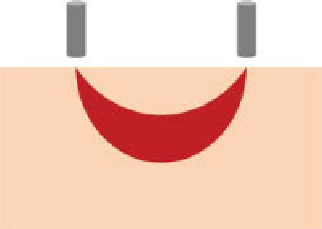Biomedical Engineering Reference
In-Depth Information
Source
Detector
FIgure 9.8
reflection light path in high scattering media.
The scattering of light by a spherical particle can be modeled by the Mie theory.
This model can be simplified by rayleigh approximation for the particles whose size
is much smaller than the wavelength of light (rayleigh region). Scattering of light
by particles much larger than the light wavelength is more directional (anisotropic)
and is usually classified as the Mie region.
In addition to scattering coefficient, the other parameter affecting the scattering of
the photons in a medium is the scattering anisotropy (
g
). The scattering anisotropy is
the mean cosine of the scattering angle in a medium. It has a value between −1 and 1.
If the optical anisotropy is 0, the photon scattering is isotropic. The photons propa-
gate in the forward/backward direction, if the optical anisotropy has a value equal to
1/−1. Figure 9.8 shows the light propagation path from a source to a detector through
a medium with optical properties similar to biological tissues. often, the Henyey-
Greenstein phase function is used to model the direction of the photon packets
in scattering media. In this model, the scattering angle,
θ
, is determined using the
following formula [38]:
2
1
2
+−
−
−+
1
g
gg
2
1
g
2
if
g
≠
0
cosθ
=
g
1
2
ξ
(9.3)
21
ξ
−
if
g
=
0
where
ξ =
φ
/2
π
and the azimuthal angle
φ
is generally assumed to be uniformly dis-
tributed between 0 and 2
π
.
In biological tissue, the scattering is often defined by another parameter as reduced
scattering coefficient
)
(
)
(
′
=
−
1
µµ
s
1
−
g
cm
(9.4)
s
The purpose of using
μ
s
′ is to describe the diffusion of photons as a random walk of
step size of 1/
μ
s
′ (cm) where each step goes through an isotropic scattering. Such a
description is equivalent to photon migration, involving many small steps 1/
μ
s
with
a partial deflection angle
θ.


Search WWH ::

Custom Search